PRIMARY & SECONDARY COLORS ART LESSON
I vowed to begin the year with a unit on teaching color theory. It means breaking out the paints when it’d be a lot easier sticking to paper and markers but what the heck, I have a sink. By second grade, most kids know the primary colors and many know the secondary colors. This lesson reinforces the idea that color combinations are infinite and just darn fun to make!
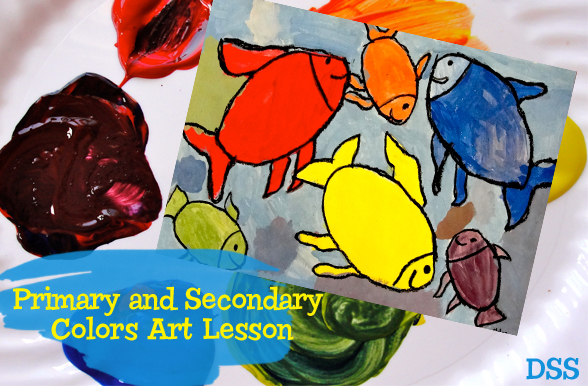
SUPPLIES:
- 12″ x 18″ White Paper
- Black waterproof marker
- Palette of red, yellow and blue (for each child…I know, lots of prep!)
- Paint brush and water containers
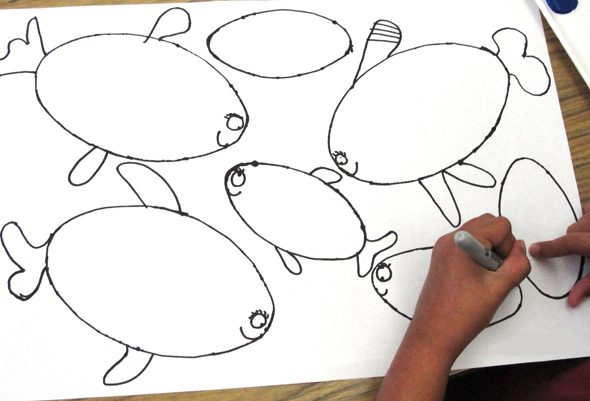
DRAWING THE FISH:
I make oval templates for the children. You don’t have to of course, but it speeds up the lesson when all anyone wants to get to is the painting! I ask the students to trace 3 big templates and three little templates. Add tails, fins, eyes, etc. But no designs…yet!
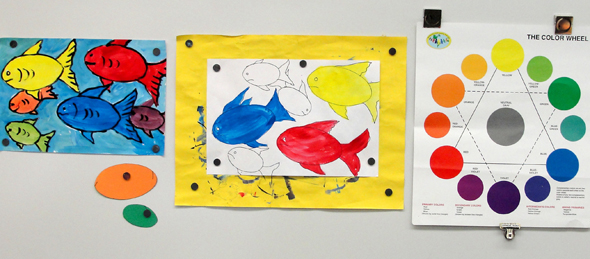
Painting the Primary Colors art lesson
Pass out a paper plate or tray with yellow, red and blue tempera paint. One for each student. Ask the children to paint one big fish yellow, one big fish red and another big fish blue. Demonstrate the importance of cleaning their brush for this colors art lesson.
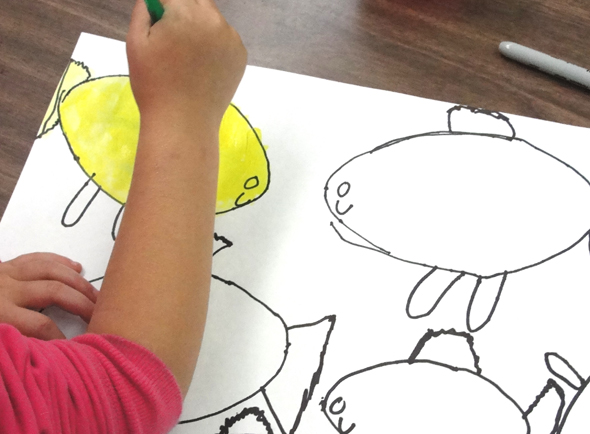
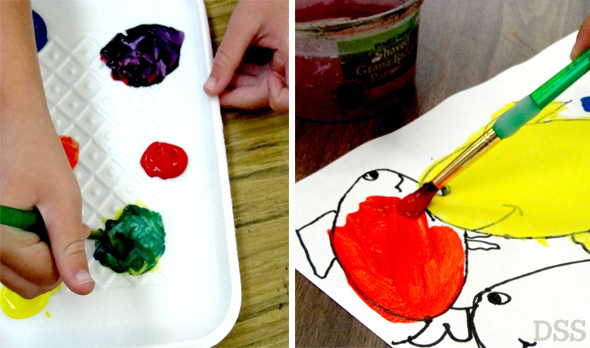
Now for the mixing. Take a tiny scoop of yellow and a tiny scoop of red and mix on the palette. Once they’ve created their orange, have them paint it on a baby fish. Do the same for blue+yellow=green and red+blue=purple.
It’s really common for some things to happen:
1. A child will trace more big fish than small fish.
2. A child will paint more than one fish yellow because the paint feels real good and he just can’t help himself.
3. The child can’t resist mixing all the colors together.
4. The child gets busy mixing all the colors and makes beautiful designs on his fish (yay!)
For all of these problems, forget it. Don’t correct or point out a problem. The lesson is in the discovery!
Adding Value: Painting the Sea
After all the fish have been painted, it’s time to bring out a tray of white paint and blue. You can put these in a well-type palette so that the kids can share. Mix blue and white directly onto the paper. Kids LOVE this part…some areas are light, some dark. It’s totally within their control.
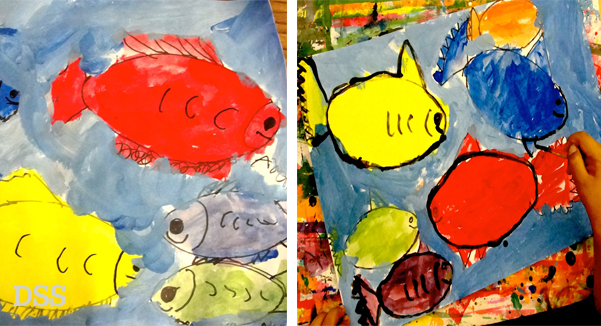
Outlining and Defining
For the final step, set out small tubs of black tempera paint and small teeny-tiny brushes. Paint over all marker lines. Add details to fish if desired. If the painting is dry, a less messy option to finishing the project is to use a black oil pastel. It’s just as effective.
Check out my post on How to Teach Color HERE, for more helpful tips, video tutorial and a free handout!

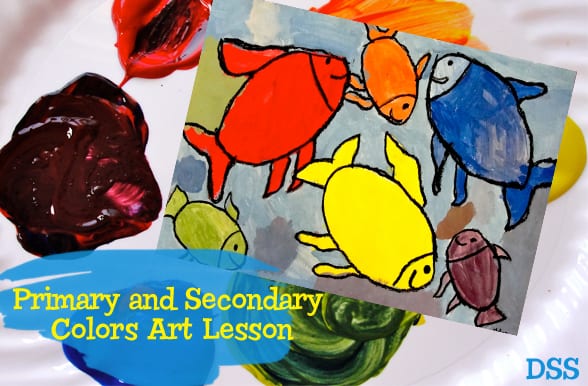











LOVE IT! Your lessons are always the best!
This is so perfect for my class on Tuesday. Your timing is impeccable. Thank you so much for sharing this great fun way to learn color theory!
Cute idea! I'll bet the kids loved it.
Such a cute lesson. I love it.
Just gorgeous- You might like to check out the Linda Kranz book – Only One You- and see her cute fish made in clay and paper- I have made both. Using the values as inspiration kids.
Thanks again, Cheryl, for another great recommendation!
Love it! I am sure the kids loved it and we as teachers secretly love it that they are learning the important color theory! When kids are having fun they truly remember the concept. 🙂
This year my goal is to do whatever art project you tell me to do!!! LOL! My class is full of 1st graders but I don't see any reason why we can't do this activity as well! I'll be giving it a try! Until you tell me what to do next… thanks! : )
nice blog.. have a view of my blog when free.. http://www.lonelyreload.blogspot.com .. do leave me some comment / guide if can.. if interested can follow my blog…
Awesome! Thanks so much for sharing your ideas and taking the time to post all of these so I can “steal” your ideas:)
We had such a fun time with this one, thank you so much for your clear cut lessons and enthusiasm for the simplistic 🙂 Here are some smiles to warm your heart: http://happyheartsmom.typepad.com/sweetness_and_light/2010/10/one-fish-two-fish-red-fish-artsy-fish.html
Many blessings,
Fun activity. I simplified it a bit and did it with my preschoolers. They loved it. Click on my name to see the blog post that includes it.
Great idea. I adapted it and used it with my 5th Grade class. Each student created a colour wheel with primary, secondary and tertiary colours. We then drew 6 fish. The head section was separated from body by a “gill”. The bodies were then painted with the primary colours. (2 of each). The heads were then painted secondary colours that were made from the primary colour on the fish body. So one yellow body got an orange head and the other got a green head. This means that there were 2 orange headed fish, 2 green headed fish and 2 violet headed fish. The fins of each fish were then painted the tertiary colour that would be made by mixing the primary body with the secondary head. The kids loved it and the fish look fantastic. The kids love saying all the cool colour names too….who wouldn’t like vermillion, amber, indigo, chartreuse, red-violet and aqua marine?
Helen!! That sounds fab!
Any chance you have pictures of the outcome?
Thanks for your recent visit to my blog and for commenting on the color mixing post. Now that I see your cute fish idea, I think I will make it and extention of my 4th graders work and have them try this assignment when they complete the spinning color wheels. I really like the creative blending in the space behind the fish.
This is such a great opening activity. The children love the scaffolding of the ovals to trace. They focus intently on spacing their fish because they want them all to fit in. I didn’t have the time to have the students paint the background, so I put blue and white on a tray and the kids sponge paint the background instead. It looks nice as well! Love this site, thank you so much for sharing.
Thanks! Love this! Did this with my sons 3rd grade class. The kids had fun, especially mixing the colors.
Hi, you may have said this. If so, sorry 🙂 What kind/brand of paint do you suggest. The color is so vibrant. Thanks!
I mostly use Crayola Washable. You can check out my art supply list here: https://www.deepspacesparkle.com/art-supply-list/
Love it! Can’t wait to have my children in the class experiment with the colors!
Very good idea it saves time and also kids have fun with colours.
Can this be adapted for watercolors? I am a 2nd semester, long term sub, Art teacher(at an “additional need’s” school)for the 1st time ever! Needless to say supplies are dwindling. I do, however, have lots & lots & lots of watercolors. Can this project be done similarly to your “A Color of His Own” oil pastel & watercolor project?
P.S. My assistant Superintendent started as an elementary art teacher & is going to bat for me with the Business Office for a membership to your site. He was VERY impressed! Thank you for making me look good 🙂
Absolutely! And I love how you think. Most every lesson can be interchanged with supplies. Here’s what I would do: if you are using watercolor paper, the kids can mix the blue and yellow on the paper to make the secondary colors.
If you are using drawing/sulphite paper with watercolors, make sure the kids mix the secondary colors in a tray. You can’t blend watercolors as well on sulphite paper.
Make sure to do the lesson yourself before teaching it 🙂
Hobbs.family@hotmail.com
Love this for starting new term with my year 2.You have included so much into the lesson but in a fun way.many thanks?
Awesome lesson! I did this last year. Read the book Mouse Paint before the lesson. Black or brown sharpies for the detail work well. I might try black chalk or oil pastel this year.
I homeschool my seven year old second grader and struggle a bit with my own artistic ability (haha!). We did this project today and it was a great success! I think the black oil pastel would’ve looked a bit cleaner than using the thin brush with black paint. Next time! On my own, I would likely not have thought to go over the marks again after painting. Thanks!
You are saving my life in this moment <3 Thanks for sharing!!
LOVE IT! Your lessons are best
Thank you for sharing. I’m going to give this a try within my “Colour” theme. I think that I will give students a choice of the objects that they want to draw/paint but with the same water (or sky background) for example, kites or flying birds.
Dear Patty,
I Love this lesson for my second graders, and have used it over and over. I am putting together a formal observation plan and I need to connect the standards to this lesson. I am a sparkler and have a membership. I have the color bundle and have done the 2nd grade Giraffe lesson which is similar to this as far as concepts go but really like this lesson much more. Could you please help me with the standards.
Hi Amber!
This lesson is in the Color Theory Bundle inside The Sparklers Club. It is called Colorwheel Fish. It will include the standards you are looking for.
PS I removed your email as I feel you may not want that showing in a public comment. 🙂
Enjoy!
This was such a great activity for my Year 2’s. We teamed it up with OK Go’s “Primary Colours’ song. Thanks a bunch!
i loved it i did it for school
Very cool. I’m going to try it with 2nd/3rd and for 3rd see how mixing tertiary colors for stripes/designs or other fish works out. Thanks!
Thank you so much for such a loving way to teach
Very well done
I have used this lesson many times. The students love it and it is worth the preparation.
Thank you! This was just what I was looking for! Can’t wait to do this project with my students!